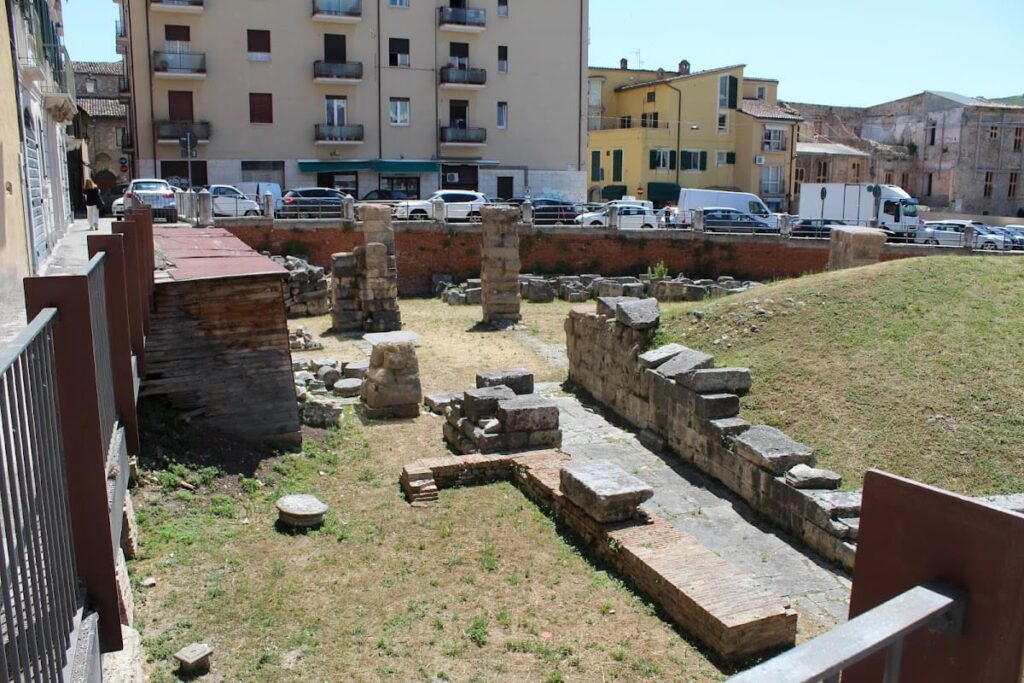Roman Theatre of Teramo: An Ancient Roman Theatre in Italy
Visitor Information
Google Rating: 4.1
Popularity: Low
Google Maps: View on Google Maps
Official Website: www.teramoculturale.it
Country: Italy
Civilization: Roman
Remains: Entertainment
History
The Roman Theatre of Teramo is located in the city of Teramo, in Italy. It was built by the Romans during the Augustan period, around 30 BCE, when the city was known as Interamnia Praetuttiorum. The theatre stood in the western part of the ancient city, likely inside the city walls near the entrance by the Via Caecilia, a road connecting Interamnia to Rome.
Constructed during the reign of Emperor Augustus, the theatre shared its era with similar Roman theatres in nearby cities such as Amiternum, Peltuinum, Hatria, and Asculum. Its stage was richly decorated with alternating rectangular and semicircular niches, reflecting the artistic style of the time. Inscriptions found at the site mention Augustus’ adopted sons, Lucius Caesar and Gaius Caesar, who died young. A headless female marble statue discovered in 1942 is believed to be part of this statuary cycle, which was expanded under Emperor Claudius.
During the Middle Ages, the theatre fell into disuse and was quarried for building materials. Stones from the theatre were reused in the construction of the 12th-century Teramo Cathedral, located adjacent to the site. Some sculpted stones from the Roman theatre remain visible in the cathedral’s north-eastern walls, both inside and outside.
Interest in the theatre’s remains revived in the early 20th century when local historian and archaeologist Francesco Savini began excavations. He led four campaigns, initially funded privately and later supported officially, though work was interrupted by World War I. In 1934, under the city’s podestà Giovanni Lucangeli, further demolition and recovery efforts took place. Engineers Sigismondo Montani and Andrea Cardellini planned to isolate and restore the theatre, but these efforts were halted by World War II.
After the war, legal disputes and private sales delayed the removal of buildings covering the site, including Palazzo Adamoli and Palazzo Salvoni. Since 2007, demolition of these overlying structures has been ongoing but remains incomplete. By 2021, only the eastern part of the stage was fully uncovered, with much of the orchestra and seating area still buried.
Remains
The Roman Theatre of Teramo lies about 2.5 to 3 meters below the current street level in the historic center of Teramo. It is situated between Via Teatro Antico and Via Luigi Paris, close to the cathedral and the Roman amphitheatre. The theatre’s layout is semicircular, with a cavea (seating area) approximately 78 meters in diameter, capable of holding around 3,000 spectators.
The seating was divided into 21 wedge-shaped sectors arranged radially, a design still visible today. The external façade likely featured two levels of arches supported by square pillars built using opus quadratum, a technique involving large squared stone blocks. Only two arches of the lower level remain visible. The cavea was supported by vaults constructed with opus caementicium, a form of Roman concrete.
Fourteen travertine steps survive as part of one seating tier. These steps connected to vomitoria, which are passageways allowing the audience to enter and exit the seating area efficiently. Additional remains include internal corridors and flooring fragments.
The theatre was part of a larger urban complex that included a nearby Roman amphitheatre. Historical reconstructions suggest the presence of an odeon, a smaller covered theatre, and a temple dedicated to the god Priapus near the site.
Sculptural finds include the headless female marble statue now displayed in the Archaeological Museum of Teramo. Some sculpted stones from the theatre were reused in the adjacent cathedral’s construction and remain visible in its walls. The theatre’s remains are fragmentary but provide valuable insight into Roman architectural and urban planning in ancient Interamnia.










